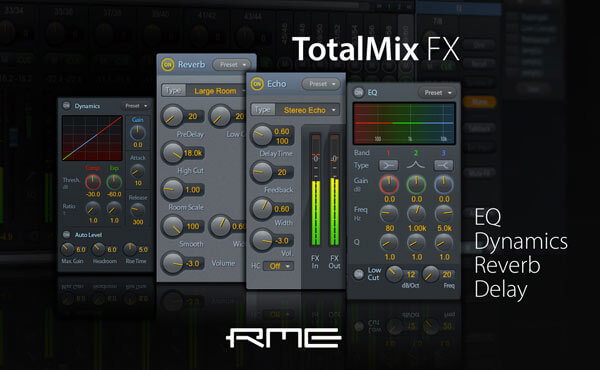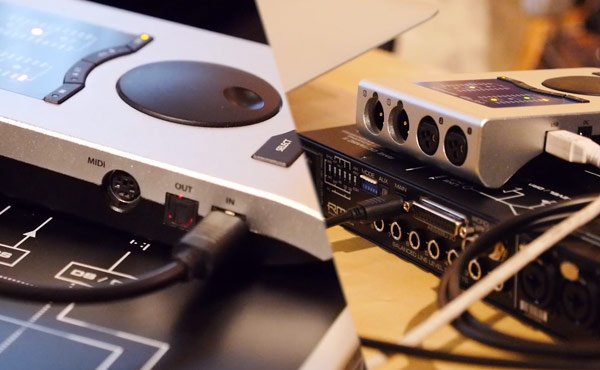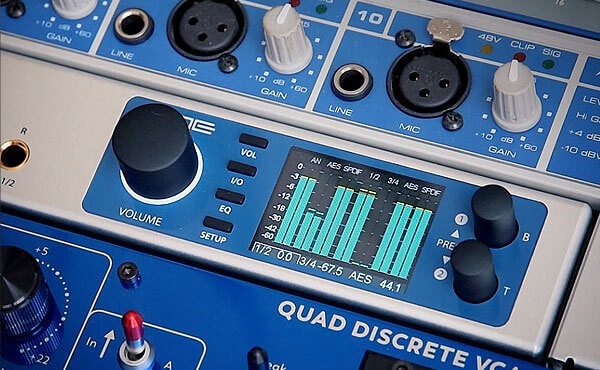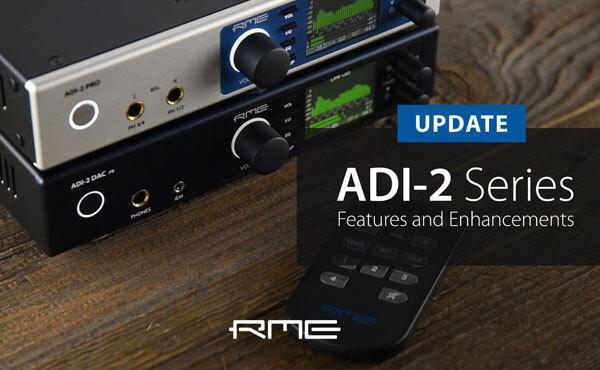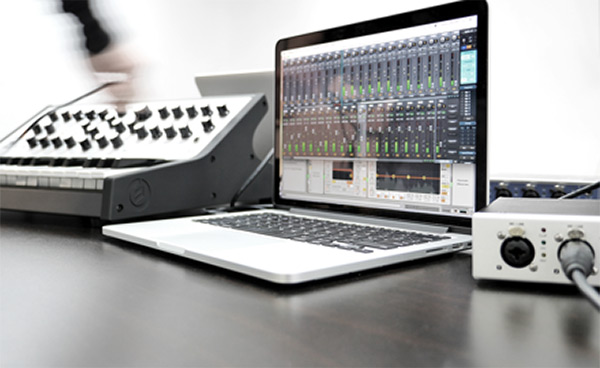Knowledge Base
RME Audio Technology explained
TotalMix FX for Beginners - Video Series
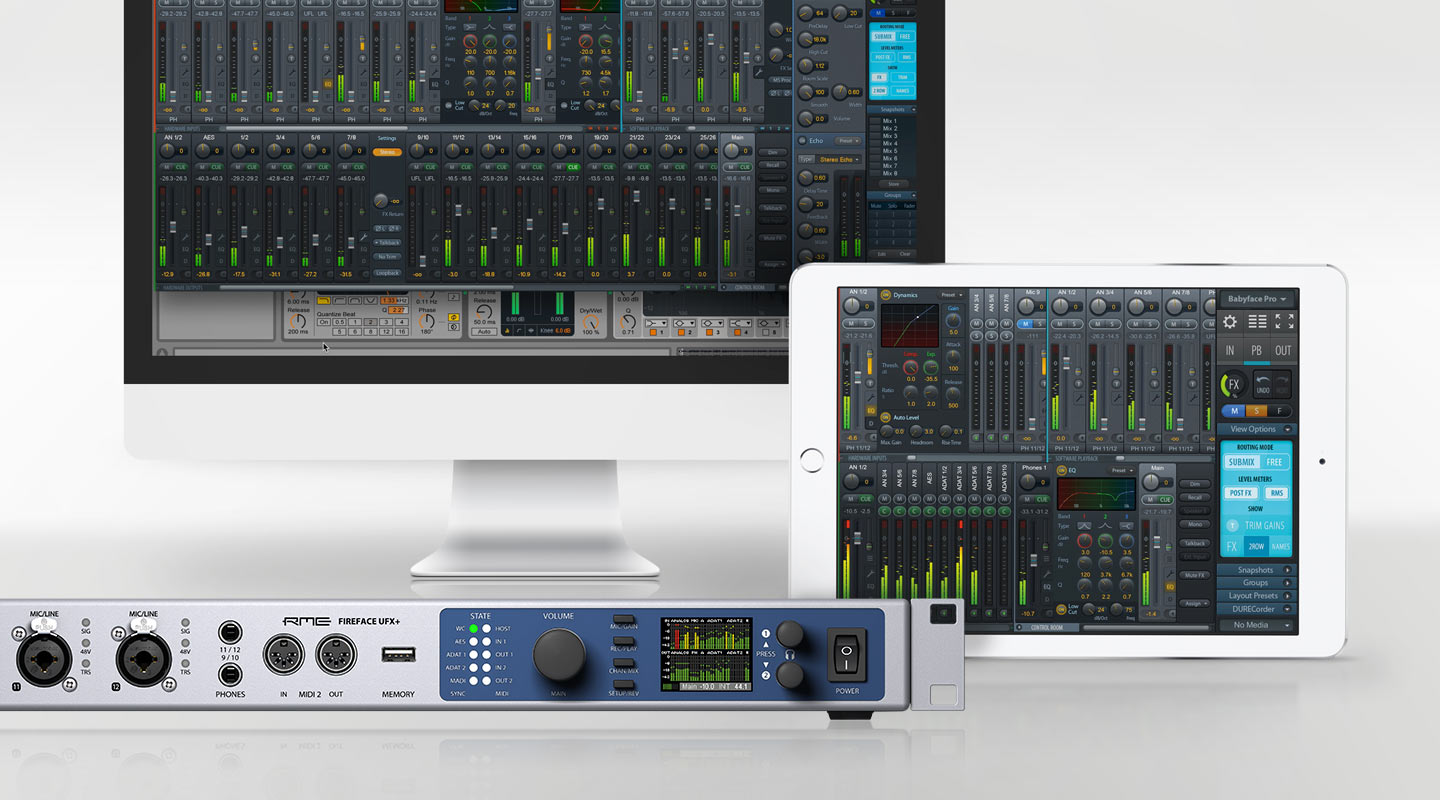
Since 2001 TotalMix added unlimited routing and mixing to RME‘s audio interfaces. Its unique capability to create as many independent submixes as output channels available turned it into the most flexible and powerful mixer of its kind.
With supported hardware, TotalMix FX includes a complete effects system, which not only adds flexibility to the recording chain, but also makes latency saddled software solutions obsolete. TotalMix FX (FX on supported cards) can completely replace an external mixer, enabling the creation of multiple latency-free monitor mixes with EQ, Dynamics, Reverb and Delay for any outputs incl. main monitors and headphone mixes for musicians.
TotalMix FX is included as part of the driver, so after you’ve downloaded and installed the latest driver and connected your interface, the mixer window will open automatically. If you’re new to TotalMix FX, you may find the number of options available to you somewhat overwhelming at first. Rest assured though, once you get to grips with the basics, you’ll find TotalMix FX to be simple, intuitive and incredibly powerful.
Check out this Video Series all about the amazing TotalMix FX features:
Glossary
RME technology explained
Most often used MADI format. Supports up to 64 channels at up to 48 kHz.
Frame format for up to 32 channels at up to 96 kHz. The advantage of this format against 48K frame using S/MUX: the receiver can detect the real (double) sample rate on its own, immediately. With 48K Frame and S/MUX, the user has to set up the correct sample rate for all connected MADI devices manually.
Electrical current that alternates direction (positive to negative). AC is often contrasted with direct current (DC), commonly produced by batteries.
Alesis Digital Audio Tape or ADAT is a magnetic tape format used for the simultaneous digital recording of eight analogue audio or digital audio tracks at once.
"ADAT" is currently used as an abbreviation for the ADAT Lightpipe protocol, which transfers 8 tracks in a single fiber optic cable. The ADAT cable standard is no longer strictly tied to ADAT tape machines, and is now utilized by analog-to-digital converters, input cards for digital audio workstations, effects machines, etc. One of the original benefits of utilizing ADAT versus S/PDIF or AES3 was that a single cable could carry up to eight channels of audio. (AES10 (MADI) can now carry up to 64 channels.)
A pair of ungrounded conductors whose voltages are opposite in polarity but equal in magnitude. Balanced lines reduce interference from external sources like radio frequencies and light dimmers.
Literally, bandwidth is a frequency span. Beyond that definition, its meaning will depend somewhat on context. For example, the bandwidth of a bandpass filter is the upper cutoff frequency minus the lower cutoff frequency (cutoff frequency being the filter's -3 dB point). The audio bandwidth is generally given as 20 Hz to 20,000 Hz, although there are harmonic components of audio that extend far above the 20k point. In most situations where bandwidth is given as an audio spec, the wider the frequency range the better. Be sure that when comparing bandwidth on different devices, that the same spec is being expressed. For example, some effects devices cite their bandwidth spec based on the dry, or unprocessed signal, while others give the bandwidth of the actual processed sound. These difference between these two specs (both listed as "bandwidth") can be substantial!
The lower end of the frequency range, from about 20 Hz to about 300 Hz.
‘Boost' in audio circles, means an increase in amplitude or gain. Often times the specific reference is in regard to equalization. For example, when an engineer says they are going to "boost 4k", this is shorthand for increasing the gain of an equalizer at 4000Hz. In essence, to boost is to increase. This does not apply to merely choosing a higher frequency on an equalizer, since no change occurs until the gain of that frequency is increased, or "boosted." The opposite of boost in equalization is 'Cut', not to be confused with Cut and Paste. Cut refers to a decrease in gain at a particular frequency. A common phrase using both terms would be, "I boosted the kick drum at 125, and cut it at 400."
Temporary RAM used in some computer operations, sometimes to prevent a break in the data stream when the computer is interrupted to perform another task.
Jargon often used in the computing world to refer to a fault in software (and sometimes hardware) that causes a malfunction. Bugs may range from minor annoyances that are easily worked around to crippling problems. Sometimes a software program can have so many problems it gets characterized as "buggy."
In audio (not transportation) terms, a Bus is a point in a circuit where many signals are brought together. For example: Most electronic items have a Ground Bus where all of a device's individual ground paths are tied together. In mixers, we have Mix Busses, where multiple channels' signals are brought (or blended) together; Aux Busses, where feeds from channels are brought together to be routed to an external processor or monitor send, etc. In general, the more busses a mixer has, the more flexible the routing capabilities of that mixer will be.
A device that can operate off of power supplied via a USB, Firewire, Thunderbolt, or other bus connection.
Bypass refers to allowing a signal to pass through a device without affecting (processing) the signal, i.e., "dry". The signal is, however, affected by any input buffers, which can impart a character or slightly degrade the signal. This differs from true bypass, as true bypass allows the signal to effectively be hardwired to the output when the effect isn't engaged.
It's a tradeoff, though. A device that bypasses rather than "true" bypasses does have some advantages, since the buffers act as input amplifiers, which allow for longer cable runs and reduce the effects of loading when ganging devices such as guitar pedals together. The downside is that even when the effect isn't engaged (when it's "bypassed"), the tone may still be slightly altered by passing through the buffer stage.
In digital data bits are arranged into what is known as "words." A byte is a binary word that is 8 bits long. A kilobyte (Kb) contains 1024 bytes (not 1000). This is because 1024 is a power of 2, which is the basis for binary digital data.
A type of weighting curve designed into filters for equipment measuring sound output levels. The C-curve is basically "flat," with -3 dB corners of 31.5 Hz and 8 kHz, respectively. It is designed to loosely correspond to how humans perceive sound at higher volume levels as indicated by curves such as the Fletcher Munson Curves.
CardBus are PCMCIA 5.0 or later (JEIDA 4.2 or later) 32-bit PCMCIA devices, introduced in 1995 and present in laptops from late 1997 onward. CardBus is effectively a 32-bit, 33 MHz PCI bus in the PC Card form factor. CardBus supports bus mastering, which allows a controller on the bus to talk to other devices or memory without going through the CPU.
Short for Category 5, a common type of twisted pair cable. Cat 5 cable is used in many networking environments for high speed data transfer. It is the current standard (replacing the former standard, Cat 3 cable) for Ethernet and fast Ethernet networks, where it is generally terminated with an RJ-45 type connector (similar to the connector many telephones use). The "category 5" standard states the twisted pairs must have at least 8 twists per foot. There are other category standards with different specifications, but Cat 5 is the most widely known and used at the consumer level right now. Most modern computers have RJ-45 type connectors built in to them for networking connections. Since this configuration has become such a common standard, component parts are widely available and inexpensive, which has caused even more widespread usage. As such we are beginning to see these connectors and cables used on more and more music equipment for certain types of communication.
Cat 6 is the highest quality twisted-pair copper cable currently available. Cat 6 has larger copper conductors than Cat 5 (Category 5, also referred to as "digital cable"), which is used for Ethernet and fast Ethernet networks, but uses the same J-45 connector. The only cable to provide a better signal quality than Cat 6 is fiber optics.
The crosstalk, or bleed of audio signals from one channel to another. The amount of channel separation is inversely related to the item's crosstalk spec; i.e. a low crosstalk spec indicates high channel separation.
In a personal computer, the integrated circuit (IC) chips that define the functions of a CPU. The chipset is in charge of controlling the flow of instructions to the CPU as well as defining the available buses. Chipsets are normally integrated - soldered onto the motherboard.On early personal computers these functions required as many as 30 individual chips. Current PCs have consolidated all these circuits into only two or three chips.
Intel (Pentium) and AMD-based computers have two distinctive chips. The northbridge typically handles communications between the CPU, RAM, and AGP or PCI Extended graphics cards. Some northbridge chips also contain integrated video controllers. The southbridge chip normally defines and controls the operation of other buses and devices, including the PCI bus,
the PS/2 interface for keyboard and mouse, the serial port, the parallel port, and the floppy drive controller.
The chipset used by a given manufacturer of motherboards can have a significant impact on the way in which that board (and the resulting computer that uses it) will interact with various peripheral devices. Some hardware, particularly more exotic audio recording hardware, can be pretty picky about chipsets and their associated data protocols.
A type of amplifier design. When an amplifier's stage devices are passing current at all times, including when the amplifier is at idle (no music playing), whether the amplifier is single ended or push-pull, the amplifier is said to be biased in Class A. Because the current is flowing at all times, an input signal causes the current to be immediately diverted to the speakers, and therefore, the sound is very "fast". In the case of a push-pull amplifier, there is also less crossover distortion when the signal passes from the positive to the negative or negative to positive, since each side of the push-pull section is already "on". If all stages of the amplifier are biased in Class A, and the amplifier operates in Class A to full output (enough current flowing at idle that could be required for full output), it is said to be a "Pure Class A" amplifier. Pure Class A designs are understandably expensive to build and are usually only found in high-end audiophile equipment.
The latter describes a standard that is natively supported by operating systems like Windows, Mac OSX and Linux. No proprietary drivers are required, the device will be directly recognized.
Background information: http://www.rme-audio.de/download/cc_mode_ucx_e.pdf
A cable consisting of a conducting outer metal tube shield enclosing and insulated from a central conducting core. Often called coax (pronounced co-ax) for short they are used for high-frequency transmission of telephone, telegraph, television, and digital audio signals. The construction of coaxial cable is designed to keep a distance between the inner conductor and the outer shield, which is one factor in determining the impedance rating of the cable. Impedances often become critically important when transmitting high volumes of data at very high rates (frequencies) and various types of coaxial cable are a common way to do this.
The condenser microphone is a very simple mechanical system, with almost no moving parts compared to other microphone designs. It is also one of the oldest microphone types, dating back to the early 1900's. It is simply a thin stretched conductive diaphragm held close to a metal disk called a backplate. This arrangement basically produces a capacitor, and is given its electric charge by an external voltage source. This source is often phantom power, but in many cases condenser mics have dedicated power supply units. When sound pressure acts on the diaphragm it vibrates slightly in response to the waveform. This causes the capacitance to vary in a like manner, which causes a variance in its output voltage. This voltage variation is the signal output of the microphone. There are many different types of condenser microphones, but they are all based on these basic principles.
In general this refers to a space - usually an enclosed room, or booth - where the operations of something are handled, the central control point. In radio and television production, this refers to the room that houses the equipment used to bring all the audio and video signals together into a composite signal that's broadcast or recorded. All the different cameras and microphones are fed into video switchers and audio mixers here. Similarly in theater applications, this is generally where all the audio signals are mixed, additional recorded sound effects may be added, and where the lighting is controlled (though these may be in separate control rooms). In theater it is sometimes referred to as a "Bio-Box," which comes from the Greek word "Bios," or Way of Life. In a recording studio, the control room has a similar function. It's where the engineers and producers sit and take care of making sure good signals get recorded as well as controlling, in many cases, what the band hears during a performance. Ideally, control rooms are designed to be carefully regulated in terms of sound isolation and accurate sound reproduction, as this is where the final decisions are made about how a recording will sound.
On some audio equipment - typically mixers - there are control room outputs and associated control room level (volume) and mix controls. This pertains to sending signals to the control room speakers, which are usually a specially selected set of very accurate speakers designed to enable producers and engineers to hear a true reference of the audio signals being recorded and mixed. In some cases these speakers are custom designed to properly react with the control room space. In other cases a control room space may be built with a specific set of speakers (and other equipment) in mind.
CoreAudio refers to the built in audio subsystems of Mac OS X. Similar in concept to the Sound Manager in Mac OS 9 and previous Mac OS', CoreAudio handles all audio communication for the system itself, and any applications written to support it. This new system is more than just a rewrite of Sound Manager, and includes many great new advances. CoreAudio now supports multichannel audio, basically as many channels as you can plug in devices for. With the advanced setup utilities in Mac OS X 10.2 (a.k.a. Jaguar) you even have the capability to select which channels from the system go to which outputs on your available hardware interfaces. CoreAudio is also ready for the future with the capability to support up to 192 kHz audio at any bit rate from 16 bit to 32 bit (yes you read that right, you can do 192 kHz at 32bit).
Central Processing Unit: the silicon chip at the center of a computer system.
Term used interchangeably for monitor mix or headphone mix.
Short for Digital to Analog Converter. Also often abbreviated DAC, which is often pronounced “dack.” A DAC is the opposite of an A/D converter. It basically reassembles the digital one’s and zero’s back into an analog waveform. One of the key ingredients in this process is filtering, which is what makes the final analog result a smooth (as opposed to digitally stair stepped) waveform. DAC’s come in a variety of configurations and price ranges.
A wiring scheme in which, for example, device A is wired to device B, device B is wired to device C, etc. All devices may receive identical signals or, in some instances, each device in the chain may modify one or more signals before passing them on. Common Daisy Chain examples would be MIDI devices connected together utilizing their THRU connections; SCSI connections with the last device terminated; certain computer network schemes; reference clock for digital studio devices; etc.
deciBel. Unit used to express the relative levels of two electrical voltages, powers or sounds.
A means of measuring the slope of a filter. The more dBs per octave, the sharper the filter slope.
A dB reference level equal to “Full Scale” or “Full Code.” It is used in specifying A/D and D/A audio data converters, but also increasingly used to refer to signal levels in the digital domain since they are almost always referenced to the full code value. Full scale refers to the maximum voltage level possible before “digital clipping,” or digital overload of the data converter. The actual Full Scale voltage is fixed by the internal data converter design, and varies from model to model. In digital metering a level of 0 dB is ostensibly equal to 0 dBFS, but in reality there may be some “fudge factor” built in either by design or by accident. Nevertheless the two can be thought of as the same thing at a practical level.
Variation on dB referenced to 0dB = 1mW into 600Ohms.
Variation on dB referenced to 0dB = 0.775 volts.
Variation on dB referenced to 0dB = 1 volt.
The progressive reduction in amplitude of a sound or electrical signal over time. In the context of a synthesizer's ADSR envelope shaper, the Decay phase starts as soon as the Attack phase has reached its maximum level. In the Decay phase, the signal level drops until it reaches the Sustain level set by the user. The signal then remains at this level until the key is released, at which point the Release phase is entered.
Digital Audio Workstations, also known as DAWs, are common in almost any studio these days. They are typically defined as having some ability to record, manipulate, and play back audio recordings or samples. In their early days Digital Audio Workstations were primarily considered editing stations. Material was taken from the primary recording media (usually tape) and dumped into one of these systems for editing, and then returned to the original media for the remainder of the project. Nowadays Digital Audio Workstations can act as an entire recording studio with all mixing, processing, and mastering on one computer.
An audio input designed to accept digital signals. A variety of digital input formats are in use, both optical and wired, including AES/EBU, S/PDIF, ADAT optical, MADI, and more.
A mixing board or console that uses DSP - digital signal processing - to combine and process audio signals. Digital mixers generally offer extended feature sets compared to analog mixers, such as built-in automation and preset memories, onboard digital effects processing, digital I/O, and in some cases, even the ability to function as an audio interface when used with a computer.
An audio output designed to send out digital signals. A variety of digital output formats are in use, both optical and wired, including AES/EBU, S/PDIF, ADAT optical, MADI, and more.
Often abbreviated DI (for direct insertion), a device commonly used to convert high impedance unbalanced signals from a stage instrument (like a bass or keyboard) into a low impedance balanced signals. This puts the signal at the proper voltage level for the mixer and prevents the instrument from becoming loaded down with too low impedance, which could cause tonal shifts and distortion. It also allows the signal to be transmitted over long lengths of cable. They are always used in live sound to get a signal out of an instrument on stage out to the mixing board, which can be as much as 500 feet away. A simple direct box consists only of a small transformer, but more sophisticated designs employ electronic gain stages that more closely resemble the input section of a modern instrument amp. They may also have some combination of ground lift switches, equalization switches, level matching switches, isolated line outputs, and more.
Distortion is ANY deviation in the shape of an audio waveform between two points in a signal path. Given that understanding, just about any audio process (equalization, compression) are all forms of distortion. Some just happen to be (hopefully) good ones. Other kinds of distortion (harmonic distortion, Aliasing, clipping, crossover distortion) are considered undesirable, though at times they are put to good use and considered a good thing.
Doubles the original sample rate range, in order to achieve higher audio quality and improved audio processing. 64 kHz is practically never used, 88.2 kHz is quite rare in spite of certain advantages. 96 kHz is a common format. Sometimes called Double Fast.
Before 1998 there were no receiver/transmitter circuits available that could receive or transmit more than 48 kHz. Higher sample rates were transferred by splitting odd and even bits across the L/R channels of a single AES connection. This provides for twice the data rate, and hence twice the sample rate. A stereo signal subsequently requires two AES/EBU ports.
The Double Wire method is an industry standard today, however it has a number of different names, like Dual AES, Double Wide, Dual Line and Wide Wire. The AES3 specification uses the uncommon term Single channel double sampling frequency mode. When used with the ADAT format, the term S/MUX is commonly used. Double Wire not only works with Single Speed signals, but also with Double Speed. As an example, Pro Tools HD, whose AES receiver/transmitter only work up to 96 kHz, uses Double Wire to transmit 192 kHz. Four channels of 96 kHz turn into two channels of 192 kHz.
Piece of software that handles communications between the main program and a hardware peripheral, such as a soundcard, printer or scanner.
Digital signal processing (DSP) is the mathematical manipulation of an information signal to modify or improve it in some way. It is characterized by the representation of discrete time, discrete frequency, or other discrete domain signals by a sequence of numbers or symbols and the processing of these signals.
The goal of DSP is usually to measure, filter and/or compress continuous real-world analog signals. The first step is usually to convert the signal from an analog to a digital form, by sampling and then digitizing it using an analog-to-digital converter (ADC), which turns the analog signal into a stream of numbers. However, often, the required output signal is another analog output signal, which requires a digital-to-analog converter (DAC). Even if this process is more complex than analog processing and has a discrete value range, the application of computational power to digital signal processing allows for many advantages over analog processing in many applications, such as error detection and correction in transmission as well as data compression.
A dynamic mic is one in which audio signal is generated by the motion of a conductor within a magnetic field. In most dynamic mics, a very thin, light, diaphragm moves in response to sound pressure. The diaphragm’s motion causes a voice coil which is suspended in a magnetic field to move, generating a small electric current. Generally less expensive than condenser mics (although very high quality dynamics can be quite expensive), dynamics feature quite robust construction, can often handle very high SPLs (Sound Pressure Levels), and do not require an external power source to operate. Because of the mechanical nature of their operation, dynamic mics are commonly less sensitive to transients, and may not reproduce quite the high frequency “detail” other types of mics can produce. Dynamic mics are very common in live applications. In the studio, dynamics are often used to record electric guitar and drums.
The range between the loudest and the softest sounds that are in a piece of music, or that can be reproduced by a piece of audio equipment without distortion (a ratio expressed in decibels). In speech, the range rarely exceeds 40 dB; in music, it is greatest in orchestral works, where the range may be as much as 75 dB.
Dynamic range in audio equipment specifications is often confused with signal-to-noise ratio. Where signal-to-noise ratio is widely considered to be the available range between the normal operating level of a device and its noise floor, the dynamic range is the maximum range available, which would imply it is the range from the highest level attainable in a unit down to the noise floor.
In music and sound recording, dynamics also refers to the dynamic range of the material. Audio passages with a large dynamic range are sometimes said to have a lot of dynamics. This is subjective and depends, to some extent, on the span of time between the loudest and softest passages.
Dynamics also refers to the general category of audio equipment designed to modify the dynamic range of audio in some capacity. This would include things like compressors, limiters, expanders, gates, etc. These are sometimes known as dynamics processors. The defining factor is that dynamics processors operate when triggered by a signal or a signal level. They are not a "static", in the sense that equalization is, for example. ("Static" meaning that the effect is applied to the signal to the same degree all of the time, regardless of level or any other dynamically varying factor.)
A generic term for the enhancement or modification of sound by the use of signal processors such as delay, distortion, chorus, reverb, phase shifting, etc.
An input on a mixer or other device intended to receive the output from an effects processor. Of course, such an input is simply a line level input, so it can be used for the output signal from any type of compatible device, not just an effects device.
An aux send or connection used to route signal to an effects processor, such as a delay or reverb.
Abbreviation for Equivalent Input Noise. EIN is a specification we most commonly encounter when looking at microphones and preamps.
The process of changing the timbral characteristics of a sound or signal by boosting or cutting the level of various frequencies or frequency ranges.
A printed circuit board fitted with a contact strip along one edge that allows it to mount into a corresponding slot in a computer. Expansion cards provide specific functionality not offered by the computer’s motherboard.
A power supply for a device that is not integrated inside the device itself - the power supply is a separate unit that resides outside the device it powers.
The IEEE 1394 interface is a serial bus interface standard for high-speed communications and isochronous real-time data transfer. It was developed in the late 1980s and early 1990s by Apple, who called it FireWire. The 1394 interface is comparable to USB though USB is more common.
The original release of IEEE 1394-1995 specified what is now known as FireWire 400. It can transfer data between devices at 100, 200, or 400 Mbit/s full-duplex data rates (the actual transfer rates are 98.304, 196.608, and 393.216 Mbit/s, i.e., 12.288, 24.576 and 49.152 megabytes per second respectively. These different transfer modes are commonly referred to as S100, S200, and S400.
IEEE 1394b-200228 introduced FireWire 800 (Apple's name for the 9-conductor "S800 bilingual" version of the IEEE 1394b standard). This specification and corresponding products allow a transfer rate of 786.432 Mbit/s full-duplex via a new encoding scheme termed beta mode. It is backwards compatible with the slower rates and 6-conductor alpha connectors of FireWire 400.
A field-programmable gate array (FPGA) is an integrated circuit designed to be configured by a customer or a designer after manufacturing.
The amount of preamplification in a microphone preamplifier before is sent in the rest of the audio chain.
See noise gate.
A headphone amplifier is an audio amplifier designed particularly to drive headphones instead of loudspeakers.
High impedance. The letter Z is often used as shorthand for the word impedance, e.g. Hi-Z or Low-Z. Hi-Z inputs are commonly used to connect an instrument (e.g. guitar) directly.
A high-pass filter (HPF) is an electronic filter that passes high-frequency signals but attenuates (reduces the amplitude of) signals with frequencies lower than the cutoff frequency.
The computer which is connected to the Audio interface and running the correct driver software.
Short for Input/Output.
Sensitivity is the minimum strength of an input signal required to produce a specified output.
All RME Premium Line units support InstantMemory™, a feature that stores your setup automatically during instances of power blackout, or during shutdown for “next day” use. All the device‘s settings are stored and recalled automatically during power down/up.
Latency refers to a short period of delay (usually measured in milliseconds) between when an audio signal enters and when it emerges from a system. Potential contributors to latency in an audio system include analog-to-digital conversion, buffering, digital signal processing, transmission time, digital-to-analog conversion and the speed of sound in air.
Process that place in a piece of software (DAW) to compensate the time delay caused in an Interface, plugins and other hardware I/O.
Monitoring an audio signal without any latency or delay.
Line level is the specified strength of an audio signal used to transmit analog sound between audio components such as CD and DVD players, TVs, audio amplifiers, and mixing consoles.
Line levels and their approximate nominal voltage levels
| Use | Nominal level | Nominal level, VRMS |
Peak Amplitude, VPK |
Peak-to-Peak Amplitude, VPP |
| Professional audio | +4 dBu | 1.228 | 1.736 | 3.472 |
| Consumer audio | -10 dBV | 0.316 | 0.447 | 0.894 |
This coincident technique employs a bidirectional microphone (with a Figure of 8 polar pattern) facing sideways and a cardioid facing the sound source. The capsules are stacked vertically and brought together as closely as possible, to minimize comb filtering caused by differences in arrival time.
The left and right channels are produced through a simple matrix: Left = Mid + Side, Right = Mid - Side ("minus" means you add the side signal with the polarity reversed). This configuration produces a completely mono-compatible signal and, if the Mid and Side signals are recorded (rather than the matrixed Left and Right), the stereo width (and with that, the perceived distance of the sound source) can be manipulated after the recording has taken place.
TotalMix FX has this function integrated in every stereo input/software channel, which allows for easy monitoring of M/S input signals.
Multichannel Audio Digital Interface, MADI or AES10 is an Audio Engineering Society (AES) standard electronic communications protocol that defines the data format and electrical characteristics of an interface that carries multiple channels of digital audio. The AES first documented the MADI standard in AES10-1991, and updated it in AES10-2003 and AES10-2008. The MADI standard includes a bit-level description and has features in common with the two-channel format of AES3. It supports serial digital transmission over coaxial cable or fiber optic lines of 28, 56, or 64 channels; and sampling rates of up to 192kHz (S/MUX4) with resolution of up to 24 bits per channel. Like AES3 or ADAT it is a uni-directional interface (one sender and one receiver).
A kind of mixer which allows you to route/mix any input to any output. TotalMix FX is a Matrix mixer.
When sound hits the diaphragm of a microphone very low voltage signals are produced. On a dynamic microphone these signals are typically around 1.5 millivolts. For a more sensitive microphone the voltage would be more like 70 millivolts.
These signals must be amplified to line level, where they are more easily manipulated by other devices such as mixing consoles and tape recorders.
A microphone preamplifier is a sound engineering device that prepares a microphone signal to be processed by other equipment. Microphone signals are often too weak to be transmitted to units such as mixing consoles and recording devices with adequate quality. Preamplifiers increase a microphone signal to line level (i.e. the level of signal strength required by such devices) by providing stable gain while preventing induced noise that would otherwise distort the signal.
MADI allows for a transmission of 64 audio channels over long distances with a single line - perfect, but what about MIDI? Be it remote control commands or sequencer data, in practice only a single MADI line might not suffice. Therefore the RME MADI devices also have MIDI I/O port facilities (exception: RME MADI Bridge and MADI Converter). MIDI data, entering at the physical MIDI input, is embedded in the output with the MADI data packages.
At the other end of the MADI line, the MIDI data can be collected at the MIDI output of another ADI-648, ADI-642, ADI-6432, Micstasy, ADI-8QS or HDSP MADI. Technically, every single MADI channel includes several additional bits, containing various information (Channel Status). RME ensures full MIDI data compatibility by utilizing the so often unused User Bit within the MADI stream to transmit the MIDI data.
Multi-mode optical fiber is a type of optical fiber mostly used for communication over short distances, such as within a building or on a campus. Typical multimode links have data rates of 10 Mbit/s to 10 Gbit/s over link lengths of up to 600 meters (2000 feet) - more than sufficient for the majority of premises applications.
A noise gate or gate is an electronic device or software that is used to control the volume of an audio signal. Gating is the use of a gate. Comparable to a compressor, which attenuates signals above a threshold, noise gates attenuate signals that register below the threshold. However, noise gates attenuate signals by a fixed amount, known as the range. In its most simple form, a noise gate allows a signal to pass through only when it is above a set threshold: the gate is 'open'. If the signal falls below the threshold no signal is allowed to pass (or the signal is substantially attenuated): the gate is 'closed'. A noise gate is used when the level of the 'signal' is above the level of the 'noise'. The threshold is set above the level of the 'noise' and so when there is no 'signal' the gate is closed. A noise gate does not remove noise from the signal. When the gate is open both the signal and the noise will pass through. Gates typically feature 'attack', 'release', and 'hold' settings and may feature a 'look-ahead' function.
Conventional PCI is a local computer bus for attaching hardware devices in a computer.
PCI Express (Peripheral Component Interconnect Express), officially abbreviated as PCIe, is a high-speed serial computer expansion bus standard designed to replace the older PCI, PCI-X, and AGP bus standards. PCIe has numerous improvements over the aforementioned bus standards, including higher maximum system bus throughput, lower I/O pin count and smaller physical footprint, better performance-scaling for bus devices, a more detailed error detection and reporting mechanism (Advanced Error Reporting (AER)), and native hot-plug functionality. More recent revisions of the PCIe standard support hardware I/O virtualization.
ExpressCard is an interface to allow peripheral devices to be connected to a computer, usually a laptop computer. The ExpressCard standard specifies the design of slots built into the computer and of cards which can be inserted into ExpressCard slots. The cards contain electronic circuitry and connectors to which external devices can be connected.
The ExpressCard standard specifies two form factors, ExpressCard/34 (34 mm wide) and ExpressCard/54 (54 mm wide, in an L-shape)-the connector is the same on both (34 mm wide). Standard cards are 75 mm long (10.6 mm shorter than CardBus) and 5 mm thick.
Phantom power, in the context of professional audio equipment, is a method for transmitting DC electric power through microphone cables to operate microphones that contain active electronic circuitry. It is best known as a convenient power source for condenser microphones, though many active direct boxes also use it. The technique is also used in other applications where power supply and signal communication takes place over the same wires.
For the HDSP MADI and the HDSP AES-32 RME have implemented a boot memory option that activates the card’s key settings immediately on power on. Rather than operating in a default mode from the moment the PC is switched on until the driver is loaded, the card will immediately activate the last used sampling rate, master/slave configuration, thus eliminating any start-up noise or problems in the clock network at system start or reboot.
Optional or included hardware that allows a piece of gear to be rack mounted. A rackmount kit typically consists of a set of rack ears that can be attached to the item for rackmounting.
All RME MADI devices can be remote controlled via MIDI. ADI-642, ADI-6432, ADI-648, Octamic XTC and the Micstasy and ADI-8QS have their own well documented protocol. All units can be be programmed with their own ID, providing a separated remote control of multiple devices via a single MIDI channel. Via MIDI the complete device status is read and set. This includes all controls and LEDs on the front plate, plus the current MADI input and output state (56/64- channel mode, 48/96 kHz frame). The TotalMixFX software for the MADI cards (HDSPe MADI/MADIface/AES ...) includes complete remote control from any controller supporting the Mackie Control Protocol.
Reverberation, in terms of acoustics, is the interpretation of the persistence of sound after a sound is produced. A reverberation, or reverb, is created when a sound or signal is reflected causing a large number of reflections to build up and then decay as the sound is absorbed by the surfaces of objects in the space - which could include furniture, people, and air. This is most noticeable when the sound source stops but the reflections continue, decreasing in amplitude, until they reach zero amplitude.
The same way that RME devices carry MIDI data along with the MADI data packages, some RME devices (ADI-642, ADI-6432) are capable of transporting RS-232 serial data via the MADI signal.
Since the ADAT hardware interface is limited to Single Speed, the Double Wire method is used for sample rates up to 96 kHz, but usually referred to as S/MUX (Sample Multiplexing). An ADAT port supports four channels this way.
The Quad Wire method allows to transmit two channels at up to 192 kHz via ADAT. The method is referred to as S/MUX4. Note: All conversions of the described methods are lossless. The existing samples are just spread or re-united between the channels.
S/PDIF (Sony/Philips Digital Interface Format) is a type of digital audio interconnect cable used in consumer audio equipment to output audio over reasonably short distances. The signal is transmitted over either a coaxial cable with RCA connectors or a plastic optic cable with TOSLINK connectors. S/PDIF interconnects components in home theatres and other digital high fidelity systems. S/PDIF is based on the professional AES3 interconnect standard.
Sample rate range originally used in Digital Audio. Typical applications are 32 kHz (digital radio broadcast), 44.1 kHz (CD), and 48 kHz (DAT).
Standard audio data transfer, where the audio signal’s sample rate is equal to the rate of the digital signal. Used from 32 to 192 kHz. Sometimes called Single Wide.
Signal-to-noise ratio (often abbreviated SNR or S/N) is a measure used in science and audio engineering that compares the level of a desired signal to the level of background noise.
In digital audio, the clock frequency is an essential factor, as it creates the correlation between the audio bits and the time reference. Unfortunately, the clock frequency is not always as stable as desired. Small fluctuations of the clock frequency are referred to as "jitter", measured in nanoseconds (ns). They are the natural born enemy of any digital audio transfer. The effects of jitter on the audio signal are many - from a somewhat rough sound quality to diminished treble localisation to clicks and dropouts in extreme cases. To solve these issues, RME have developed a completely new technology for synchronization and jitter suppression in digital audio signals - SteadyClock.
Normally, the circuitry for clock synchronization consists of an analog PLL (Phase Locked Loop) and several quartzes for the various frequencies. Such PLL systems sync very fast, but do not provide jitter suppression. Ceramics filters or special DDS-Chips (Direct Digital Synthesis) define systems with active jitter suppression, but with slower sync speed, and tend to be very costly.
SteadyClock works with only one crystal, an internal clock reference of 200 MHz, and an internal DDS clock generator which resides within the FPGA (Field Programmable Gate Array). Thus the circuitry was optimized for audio transfer, resulting in extremely fast synchronization between 28 and 200 kHz and very efficient jitter suppression.
The SteadyClock technology guarantees an excellent performance in all clock modes. Its highly efficient jitter suppression enables RME devices to refresh and clean up any clock signal, and to provide the clock signal as reference clock at the word clock output. At the same time, analog conversion is performed on a guaranteed level of highest quality, completely independent from the kind and quality of the used reference clock. The cleaned and jitter-freed clock signal can be used as reference clock in any application, so the quality of the external (input) clock doesn’t matter anymore.
A switched-mode power supply (switching-mode power supply, SMPS, or switcher) is an electronic power supply that incorporates a switching regulator to convert electrical power efficiently. Like other power supplies, an SMPS transfers power from a source, like mains power, to a load, such as a personal computer, while converting voltage and current characteristics.
RME Premium Line and several Pro Line products use internal switching power supplies. This technology offers several advantages over standard 'linear' regulated power supplies, like worldwide operation with any voltage between 100 and 240 Volts, 50 or 60 Hz. Additionally it is short-circuit-proof, has an integrated line-filter, is fully regulated against voltage fluctuations, and suppresses mains interference. The high efficiency factor keeps the units cool. RME's high frequency design eliminates mechanical hum and induced ground loops.
RME's exclusive SyncCheck monitors all input signals and displays their actual state. With Intelligent Clock Control™ (ICC) you keep control of all clocks and sync states.
The Tascam Digital Interconnect Format (TDIF) is a proprietary format connector defined by TASCAM that is unbalanced and uses a 25-pin D-sub cable to transmit and/or receive up to eight channels of digital audio between compatible devices. Unlike the ADAT lightpipe connection, TDIF uses a bidirectional connection, meaning that only one cable is required to connect the eight ins and outs of one device or another.
Three-contact versions are known as TRS connectors, where T stands for "tip", R stands for "ring" and S stands for "sleeve". The kind of connector that can be found on headphones.
See Bus powered.
The Windows Driver Model (WDM) - also known at one point as the Win32 Driver Model - is a framework for device drivers that was introduced with Windows 98 and Windows 2000 to replace VxD, which was used on older versions of Windows such as Windows 95 and Windows 3.1, as well as the Windows NT Driver Model.
A word clock or wordclock (sometimes sample clock, which can have a broader meaning) is a clock signal used to synchronize other devices, such as digital audio tape machines and compact disc players, which interconnect via digital audio. S/PDIF, AES/EBU, ADAT, and TDIF are some of the formats that use a word clock. Various audio over Ethernet systems use broadcast packets to distribute the word clock. The device which generates the word clock is the master clock.
Word clock is so named because it clocks each sample. Samples are represented in data words.
The XLR connector was invented by James H. Cannon, founder of Cannon Electric in Los Angeles, California (now part of ITT Corporation), and for this reason it was sometimes colloquially known as a Cannon plug or Cannon connector and in Japan as Cannon jack.
The XLR connector is a style of electrical connector, primarily found on professional audio, video, and stage lighting equipment. The connectors are circular in design and have between 3 and 7 pins. They are most commonly associated with balanced audio interconnection, including AES3 digital audio, but are also used for lighting control, low-voltage power supplies, and other applications. XLR connectors are available from a number of manufacturers and are covered by an international standard for dimensions, IEC 61076-2-103.
No latency. See Latency.
RME USB - Transport audio with lowest latency and industry leading stability

As part of RME’s product philosophy, we always further develop and optimize our core technology. RME have paved the way for multichannel audio and were the first to deliver professional performance over USB 2.0.
We place a high level ofattention on the development of reliable, stable, and regularly updated drivers for our products and an unwavering focus on audio quality. This guarantees your RME Audio Interface will be never outdated and always updated. And because RME Audio develops its own interface core, it’s not dependent on 3rd parties for upgrades, modifications or bug fixes, so customers can use latest operating systems without interruption or delay.
Find out more about the benefits of using RME USB Technology
(DURec) - Direct USB recording for all Inputs and Outputs
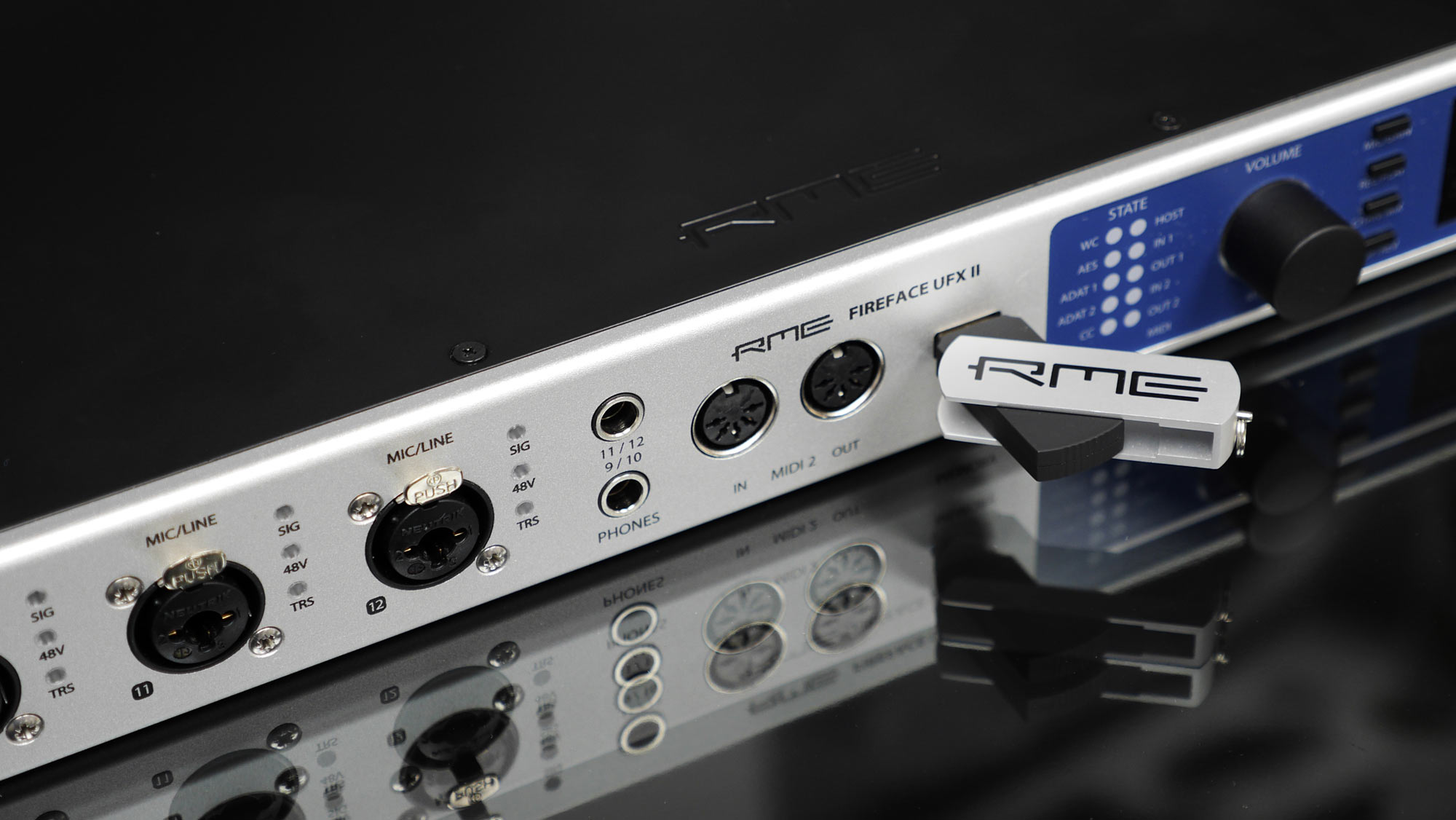
DURec is an integrated digital recorder for all inputs and outputs directly to USB memory devices via the front USB port. The Fireface UFX+ and Fireface UFX II records on USB thumb drives or hard drives with up to 2 TB capacity. The recording functionality is provided by the internal DSP, and is therefore independent from a connected Windows or Mac computer.
The Direct USB Recording converts the Fireface UFX Series both into a stand-alone field recorder and a powerful multichannel live player for previous recordings, e. g. for virtual sound checks. Live concerts, band rehearsals or spontaneous jam sessions can be directly recorded and played back from the medium - even completely stand-alone without computer or software. All 60 input and output channels can be individually chosen for recording and playback.
DigiCheck - The Secret Weapon of High Resolution Audio Measurements

RME‘s unique software tool box for metering, testing, measuring and analyzing digital audio streams. 2, 8 or all channel level meters with countless options. Spectral Analyzer, Goniometer and Bit Statistics in professional quality. Even Channel Status readouts are possible. Under Windows DIGICheck also offers a global record function and the direct readout of playback data. Available for free download from RME‘s Website.
SteadyClock FS - Full range capture without Compromises
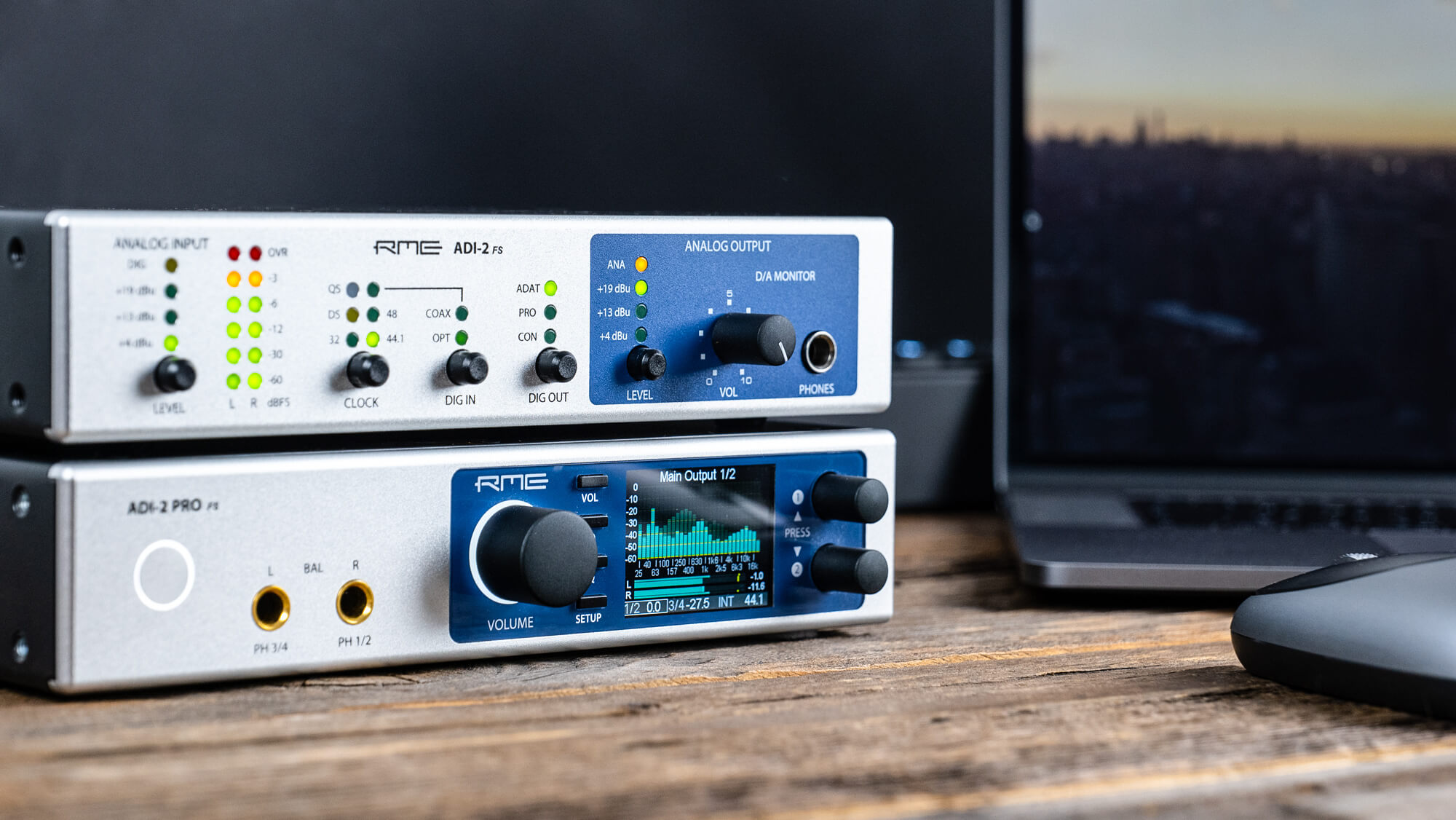
RME‘s jitter suppression technology guarantees perfect sound quality throughout, making thedevice completely independent from the external clock signal‘s grade. Due to the highly efficient jitter reduction, the converters operate as if they are working with internal clock all the time - guaranteeing a pristine sound experience!
AutoSet - Automatic gain reduction and overload protection technology
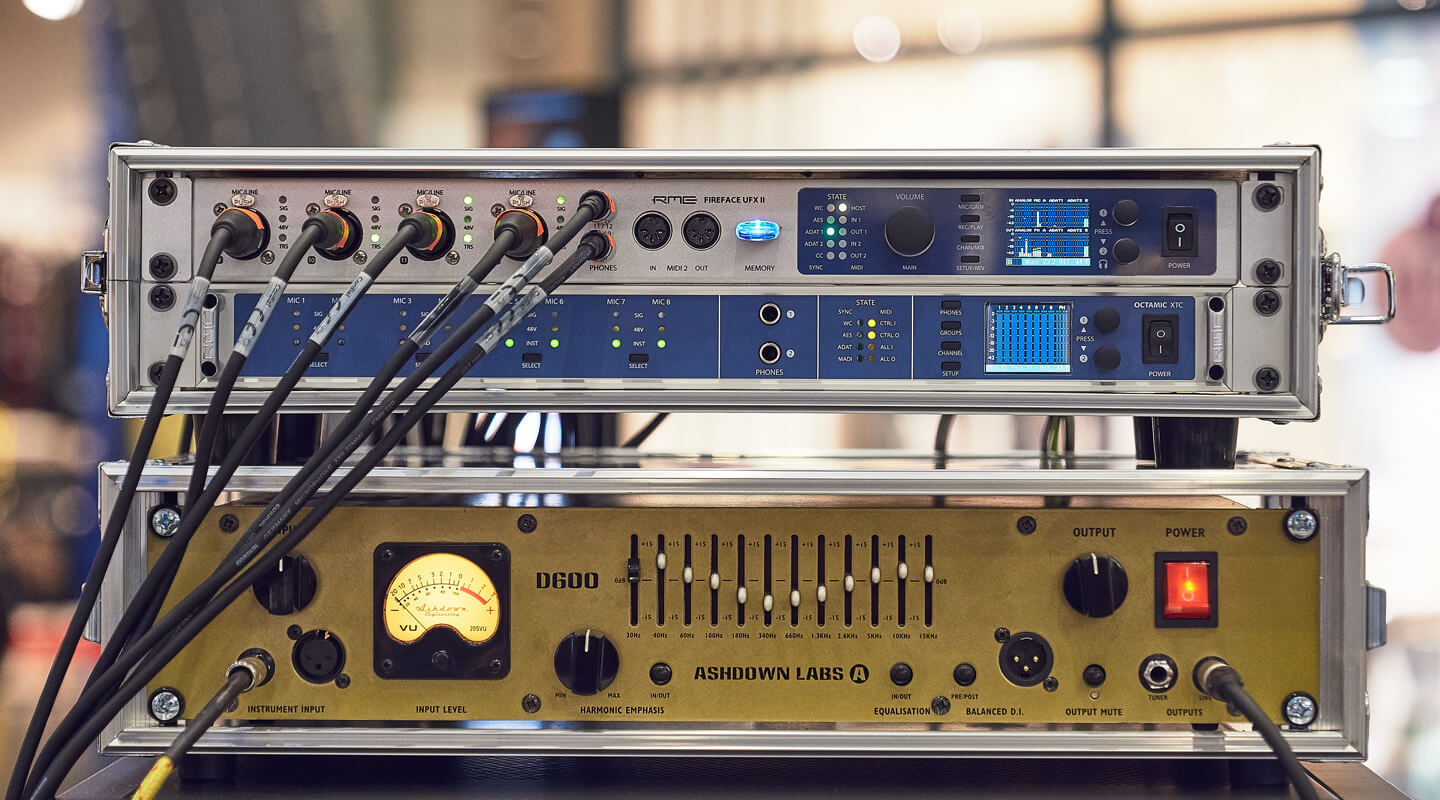
Usually a limiter is used during the recording to prevent clipping of the A/D converter stage. But analog processing would not only spoil the excellent technical specifications of mic preamps but also alter the original sound.
Thanks to the completely digitally controlled gain, devices with AutoSet can reduce the gain automatically, thus providing perfect protection from overload with no degradation of the audio signal, which does not have to pass any additional electronic circuitry. AutoSet also does not cause any of the control noises known from usual limiters.
Class Compliant Mode - Professional analog I/O connections for iPad
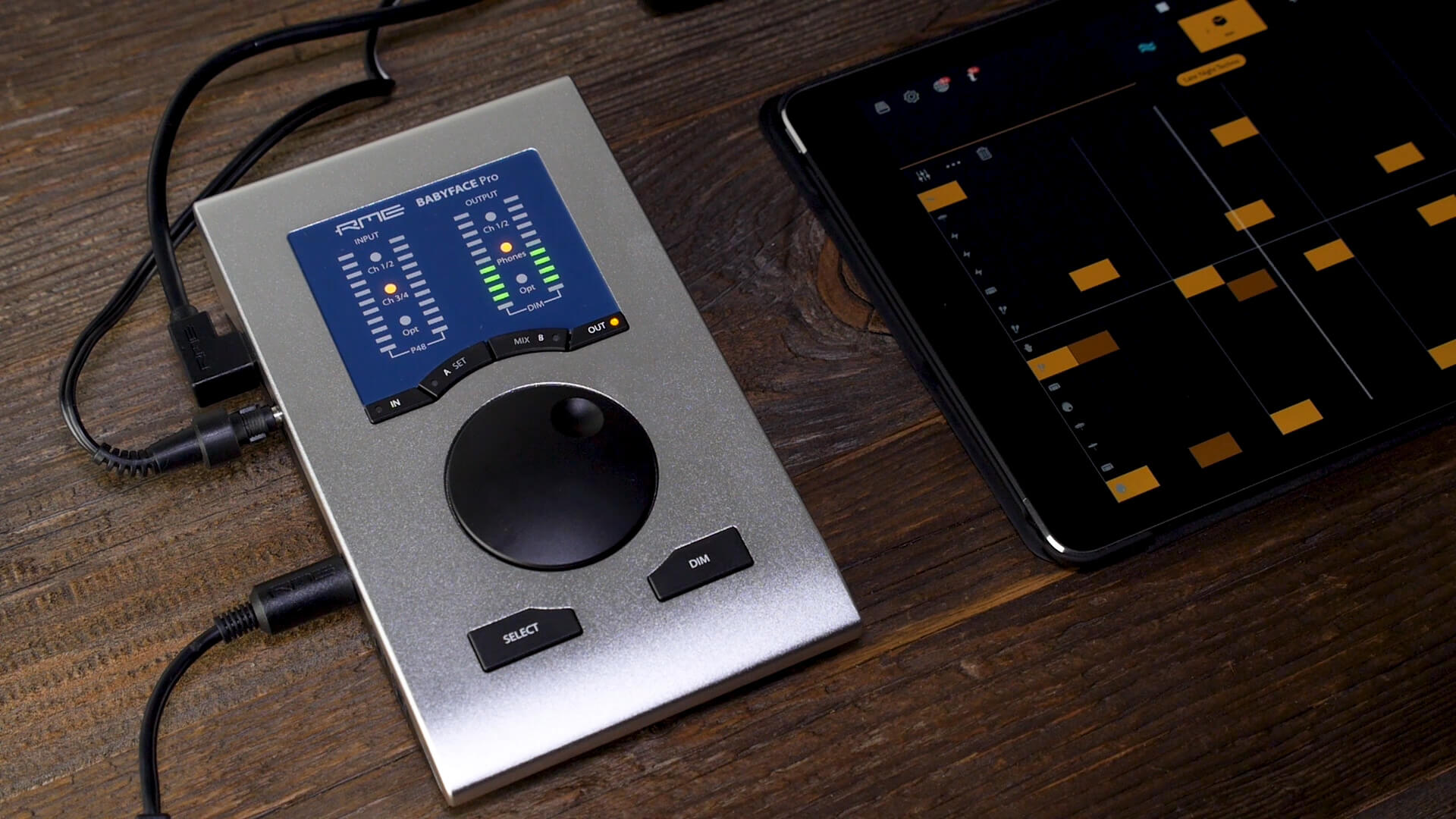
The Class Compliant mode is a standard that is natively supported by operating systems like Windows, Mac OSX and Linux distributions. No proprietary drivers are required, the device will be directly recognized when the CC mode is activated by the button on the front panel.
RME Interfaces - Equipped with Premium Plug-ins
The virtually unlimited variety of sounds and effects combined with class-leading Interfaces from RME Audio.

